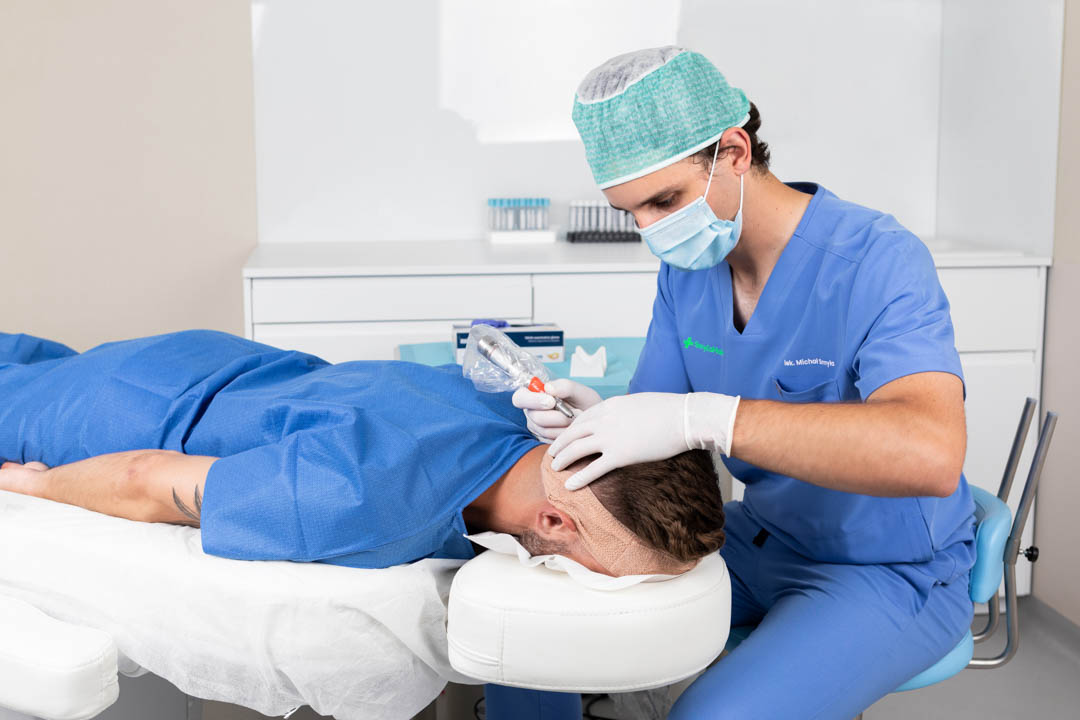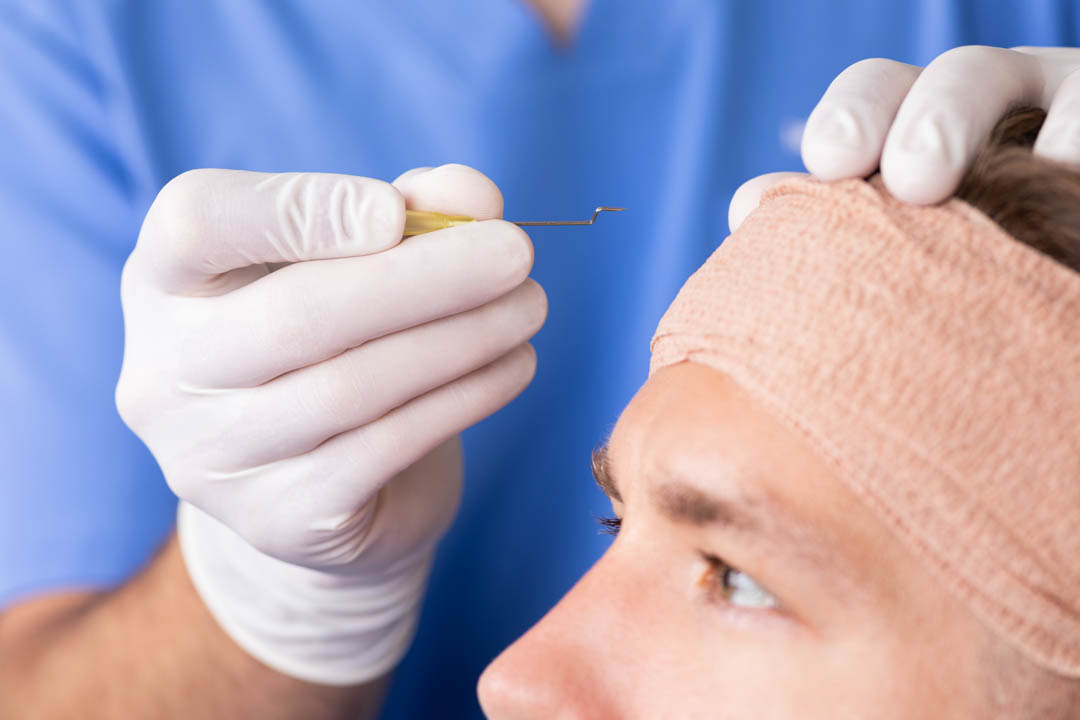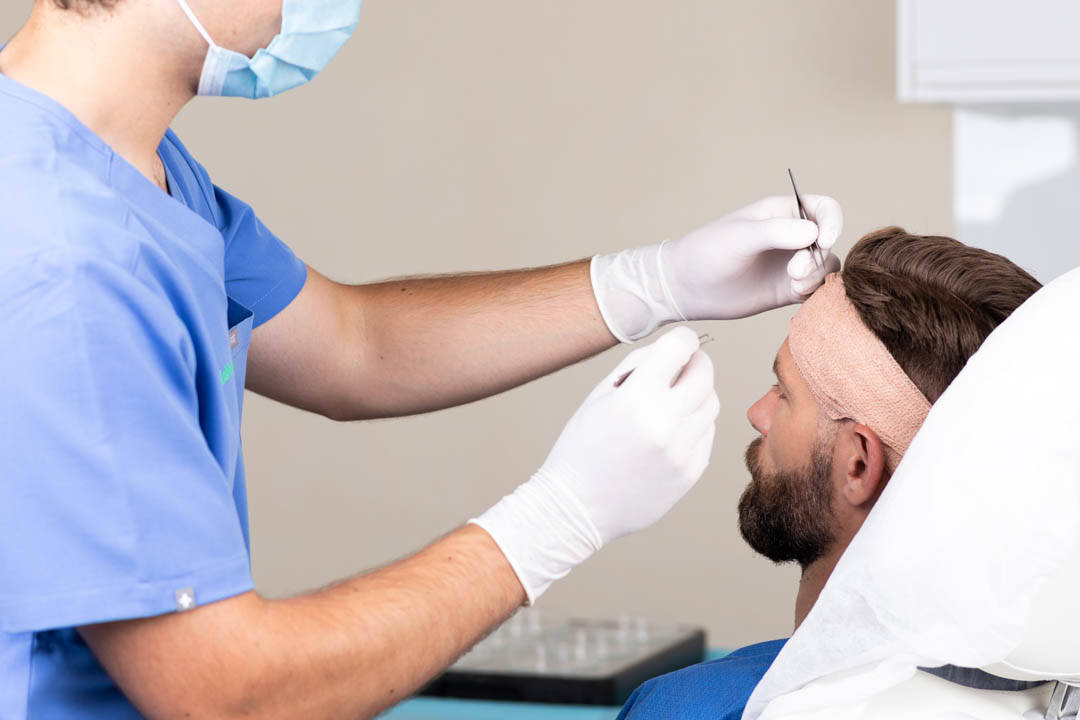FUE hair transplant
FUE hair transplant
is a minimally invasive procedures in which hair follicles are taken from strong areas of your head (back and sides) and then aesthetically implanted in balding areas.
Opening promotion – all hair transplants at CHF 3999.
What does the procedure look like?

1. Consultation
Before the procedure, we will help you choose the optimal hairline and determine the safe amount of follicles to be transplanted.
The consultation includes:
- preoperative interview,
- videodermatoscopic examination,
- determination of the safe donor area,
- drawing your new hairline.
2. Anesthesia
The procedure begins with the administration of anesthesia to the donor and recipient area.
FUE hair transplantation is:
- performed entirely under local anesthesia,
- virtually painless.


3. Harvesting of the grafts
The next stage is the collection of follicles:
- They are taken using small-diameter, trumpet-shaped punches (0.7-0.9 mm).
- This makes the donor sites almost invisible about a week after the procedure,
are taken only from a pre-marked safe donor area.
The rest of the team prepares the follicles for implantation:
- assesses and sorts them based on thickness and hair count,
- transfers them to a holding solution and cools them.
4. Recipient site creation
Using a sapphire blade, we prepare incisions for each harvested follicle.
This stage is particularly important for us in order to create a natural, aesthetically pleasing look.


5. Implantation of the grafts
In the final step, the follicles are implanted one by one into the previously prepared recipient sites (or directly in the case of the DHI method):
the follicles go into the appropriate areas depending on how many hairs they contain – the goal is to achieve the most natural look.
Success!
From now on you can enjoy your new hair – permanently!
Am I a good candidate?
If you are at least 25 years old and do not suffer from serious chronic diseases, you are most likely a good candidate for FUE hair transplantation.
Chcesz być pewien?
Skorzystaj z darmowej, niezobowiązującej konsultacji.
Oddzwonimy do Ciebie w ciągu 24h.
Administratorem danych jesteśmy my, czyli Michał Smyła NIP 6462963492 z siedzibą przy al. Niepodległości 36, 43-100 Tychy. Dane będą przetwarzane w celu udzielenia odpowiedzi na zapytanie zgodnie z regulaminem.
Lub wypełnij formularz konsultacyjny online:
Free online analysis
Within 24 hours, you will be contacted by a doctor and presented with treatment options.
Prices
FUE hair transplant
popular
promotion: CHF 3999
promotion: CHF 3999
promocja
Small procedure (<1500 grafts)
CHF 3499
Medium procedure (1500-2500 grafts)
CHF 4999
Large procedure (2500-3500 grafts)
CHF 5999
Very large procedure (3500-5000 grafts)
CHF 6999
BHT (Body Hair Transplant)
CHF 1,5 / graft
Beard transplant
CHF 1,5 / graft
Consultation
free
Included:
- Care kit
- Food and beverages
- Hotel stay
Frequently asked questions
Frequently asked quetsions
A hair transplant is a medical procedure in which so-called follicular units, i.e. naturally occurring groups of 1 to 4 hairs, are taken from genetically strong areas (the back and sides of the head – the donor area) and transferred to bald or balding areas: the front, top and top of the head (the recipient areas), where they grow permanently.
FUE hair transplant prices at the ZüriHair clinic start at CHF 3499. The full price list is as follows:
- Small procedure (<1500 grafts): CHF 3499
- Medium procedure (1500-2500 grafts): CHF 4999
- Large procedure (2500-3500 grafts): CHF 5999
- Very large procedure (3500-5000 grafts): CHF 6999
FUE hair transplantation is an almost painless procedure – it is performed under local anesthesia from start to finish.
Some patients may experience minor pain after the anesthesia has worn off – but it is easily controlled with over-the-counter pain medications.
FUE hair transplantation leaves no linear scars.
The areas from which the follicles were taken are very small in diameter (0.7-0.9 mm) and become almost invisible after only about a week after the procedure.
Yes. The effects of FUE hair transplantation are permanent – the transplanted hair will not fall out.
If you are at least 25 years old and do not suffer from serious chronic diseases, you are most likely a good candidate for a hair transplant.
However, only a consultation with a doctor will give you complete certainty.
ZüriHair offers a free, no-obligation online consultation – we will respond within 24 hours.
The two main methods of hair transplantation, which differ in how the follicles are harvested, are:
- FUE – Follicular Unit Extraction – a newer, minimally invasive method in which hair follicles are extracted one by one directly from the scalp (back and sides of the head). Using punches with a diameter of 0.7-0.9 mm, the surgeon makes incisions around the hair follicles, allowing them to be extracted. In their place, small holes are left, which heal a few days after the procedure, leaving almost no trace.
- FUT (STRIP) – Follicular Unit Transplantation – an older method in which the surgeon cuts an elongated flap of skin along with subcutaneous tissue at the back of the head with a scalpel. The flap is then precisely sectioned under a microscope into individual follicular units.
The follicular units, regardless of how they are harvested (FUE/FUT), are then implanted in the balding areas in the same manner.
Advantages of FUE hair transplantation:
- The procedure does not leave linear scars
- It is near-painless
- Short recovery period
- It is possible to take grafts from areas such as beard, chest
Disadvantages of FUE hair transplantation:
- The procedure takes longer than a FUT (STRIP) transplant.
- It is more expensive than FUT (STRIP) transplantation
Depending on the extent of the procedure – FUE hair transplantation takes from 4 to 12 hours.
You can check the exact course of the entire procedure here.
The holes in the back of the head heal after 3-5 days after the procedure, the transplanted hair takes a little bit longer (up to 10 days).
Depending on the type of work you do, you may even be able to return to work the next day. However, most patients allocate 8-12 days for recovery.
A week after the procedure, you can return to moderate physical activity.
You can find detailed instructions on how to proceed after the procedure here.
A few days before the procedure, do not consume alcohol, smoke or take medications containing acetylsalicylic acid (Aspirin). Laboratory tests should also be performed.
For detailed instructions on preparing for the procedure, click here.
In the first two days after the procedure, the transplanted hair should be sprayed with saline that you will receive from us. Avoid scratching or prolonged exposure to the sun.
You can find the exact post-treatment instructions here.
Pre- and post-op care
Pre-op care
Laboratory tests you need to perform 10 days before the procedure:
- Complete blood count
- Glycemia
- Coagulogram (APTT and INR)
- General urinalysis
- Serological tests:
- HIV (Combo)
- HBV (HBs antigen)
- HCV (anti-HCV antibodies)
Send the results to us by email (michal@zurihair.com) or bring them with you to the procedure.
7 days before the procedure:
- Do not take any medications containing acetylsalicylic acid (Aspirin) 7 days before and 7 days after surgery. Many over-the-counter medications may contain acetylsalicylic acid, such as Aspirin.
- Do not take any painkillers/anti-inflammatory drugs 7 days before surgery, e.g. Ibuprofen, Naproxen, Diclofenac. If you need to take a painkiller, you can use paracetamol.
- Do not take dietary supplements, including herbal supplements, and B and E vitamins 7 days before and 7 days after surgery. These substances can increase bleeding and react with anesthetics. For example, do not take: fish oil, melatonin, green tea, garlic extract.
- Stop all forms of tobacco use 2 weeks before and 2 weeks after the procedure (cigarettes, snuff, but also preparations to help you quit smoking – such as patches, gums). Nicotine in any form can significantly delay the healing process.
- Stop drinking alcohol (including beer and wine) 48 hours before and 48 hours after the procedure.
- Medications taken on a regular basis: Take medications as prescribed by your doctor (e.g., medications for high blood pressure, asthma, finasteride).
- If you are taking medication for arthritis (e.g., rheumatoid – RA), inform us before the procedure for additional qualification.
- If you have diabetes, bring a glucometer with you on the day of surgery.
- If you have asthma, bring your inhaled medications with you on the day of surgery.
- If you are using Loxon (minoxidil), stop using it 2 days before the procedure. You can resume using Loxon 7 days after the procedure.
- Wash your hair in the morning on the day of the procedure. Blow dry it and do not apply any additional products (e.g. gel, gum, conditioners).
Day of the procedure
On the morning of the treatment day:
- Wash your hair. Blow-dry it and do not apply any additional products (e.g. gel, gum, conditioners).
- Eat a normal breakfast.
- Wear comfortable clothes that go over your head easily (e.g., shirt, unbuttoned sweatshirt). You can also take loose headgear with you.
- Take your test results and medications with you (if you are taking them on a regular basis).
Post-op care
General instructions
- The effects of medications used during the procedure may persist for 24 hours after the procedure. Symptoms may include drowsiness, dizziness, confusion, nausea, redness/irritation of the skin head If you experience any of these symptoms, we recommend that you remain under adult supervision for 24 hours.
- Drink plenty of fluids. You can return to eating immediately after the procedure – there are no restrictions on diet.
- Pain after the FUE procedure is rare, but if you are in pain, take Ibuprofen 400 mg every 8 hours (after meals). Be cautious if you have/had stomach disease, especially peptic ulcer disease. You can also take paracetamol (Apap).
- Do not drink alcohol for 48 hours after the procedure.
- Contact us if you experience any of the following symptoms:
- Pain that does not subside after taking the maximum dose of pain medication.
- Bleeding from the surgical site that does not subside after pressure for 5 minutes
- Fever above 38.0 degrees Celsius for up to 7 days after surgery
- Signs of infection of the surgical site, such as severe redness, swelling or pain, yellow/green exudate
- A rash on the body
- Nausea and vomiting that is not relieved by taking antiemetics
- Call 112 if you experience swelling of the lips, tongue or throat that makes it difficult to breathe
The first night after the procedure
What to expect
- The scalp will be reddened
- The back of the scalp (donor area) will show small wounds. This is normal and will heal up to 3 days.
Hair and scalp care
- Do not wash your hair for more than 24 hours after
- Start spraying the transplanted hair with the aerosol you will receive from us – in the first day, spray every 20 You can put a towel on your shoulders to drip excess liquid on it.
Eating
- Eat dinner. There are no restrictions on
- Do not drink alcohol for 48 after the procedure.
Sleep
- Sleep with your head elevated – using two pillows. There may be exudate from the donor site (back of the head), so we recommend that you place a dark towel over the pillows.
Day 1 after the treatment
What to expect
- The redness of the scalp will be paler, but may still persist.
- Scabs may appear, which will disappear by 10-14 days.
Hair and scalp care
- Do not touch, scratch or rub transplanted hair, and avoid prolonged exposure to the sun.
- Spray the transplanted hair with a spray every 1-2 hours.
- You can wash your hair, but wait until the evening. Wash your hair gently, using normal shampoo and low water pressure. Dry your hair only by applying a towel, preferably a disposable one (do not rub) and comb your hair only with your fingers (do not use brushes, combs).
- You can apply a cream to the donor area (back of the head) to promote wound healing, such as Cicatridine.
Physical activity
- Limit physical activity.
Sleep
- Sleep with your head elevated on two pillows.
Day 2-7 after treatment
What to expect
- Redness/pigmentation of the scalp may persist for up to a week after the procedure.
- There may be swelling on the forehead and around the eyes 2-3 days after the treatment.
Hair and scalp care
- Transplanted hair is already stronger, but continue to avoid touching, scratching, rubbing and prolonged exposure to the sun.
- On -3rd day, spray the transplanted hair with a spray every 1-2 hours – or until the liquid is exhausted.
- Wash your hair gently, dry only by applying a towel. On Day 4, you can start back using hair preparations other than shampoo. You can use a brush and blow dryer, but be careful.
- You can apply vitamin A ointment to the scabs at night.
- If swelling occurs, apply ice to the forehead and/or the donor area (back of the head). Do not put ice directly on the transplanted follicles (recipient area). If swelling is severe, use medication as directed.
Physical activity
- You can return to light physical activities, such as gentle running, gentle strength training.
- Avoid swimming pool and sauna for 2 months after surgery.
Sleep
- Sleep with your head elevated on two pillows.
Week 2-4 after the procedure
What to expect
- You may begin to lose transplanted hair – this phenomenon is normal. The loss may last up to 4-6 weeks. This hair will grow back within 3-4 months.
- Lumps/pimples may appear in the recipient area. They should disappear on their own, but you can use Microdacyn spray or antibiotic ointment (such as Tribiotic) on them.
Hair care
- You can return to washing your hair normally. If scabs persist, stay in the shower longer, use conditioner and massage the recipient area to remove the scabs.
- You can return to using Loxone and LLLT laser.
- You can cut or color your hair after the 10th day of treatment.
Physical activity
- You can return to full activity
Month 2.-3. after the procedure
What to expect
- Transplanted hair begins to grow. During this period, existing hair may begin to fall out – this phenomenon is normal, these hairs will grow back.
- During the period of intensive growth of transplanted hair, there may be irritation of the recipient area, which will disappear spontaneously after most of the transplanted hair grows out.
Hair and scalp care
- Avoid overexposure to sun (use a head covering or SPF filters).
6 months after the procedure
What to expect
- Transplanted hair becomes thicker,
Hair and scalp care
- Avoid overexposure to sun (use a head covering or SPF filters).
12-18 months after the procedure
You can see the final result of the hair transplant. Congratulations!